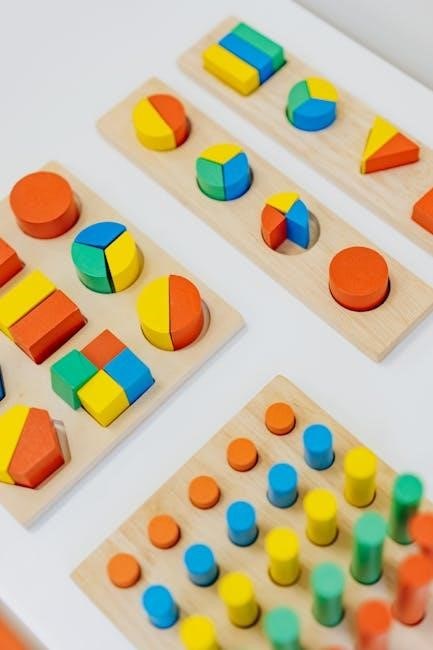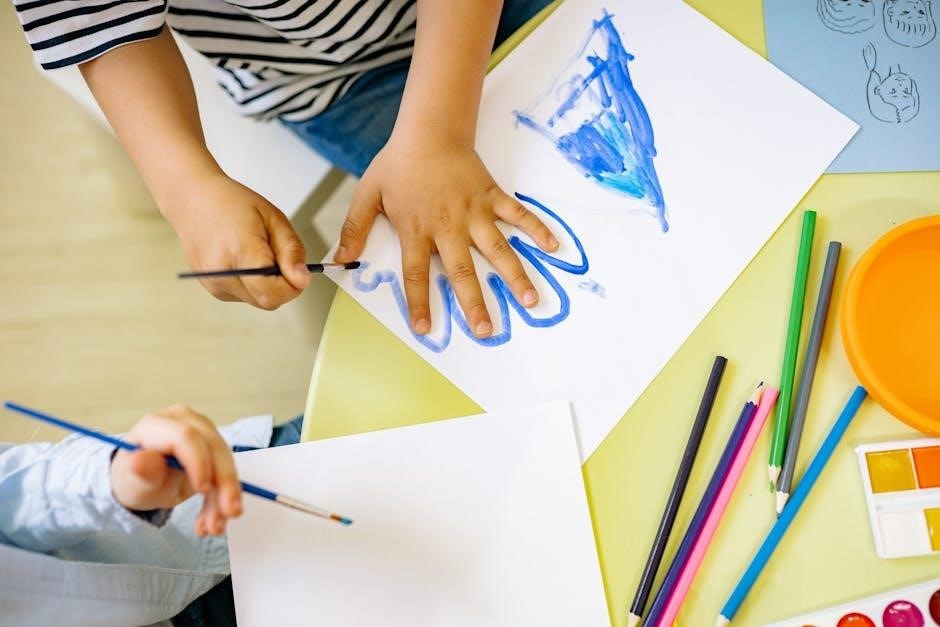The kindergarten curriculum guide provides a comprehensive framework for early childhood education, focusing on foundational skills, social-emotional development, and creativity through play-based learning experiences.
1.1 Overview of the Importance of Kindergarten Education
Kindergarten education lays the foundation for lifelong learning, fostering social-emotional growth, literacy, and numeracy skills. It introduces children to structured learning environments, promoting creativity, curiosity, and collaboration. This stage is crucial for developing foundational abilities that support future academic success and personal development, ensuring children are well-prepared for the challenges ahead.
1.2 Key Objectives of a Kindergarten Curriculum
The primary goals of a kindergarten curriculum include fostering literacy, numeracy, and social-emotional skills. It aims to encourage curiosity, creativity, and independence while promoting physical and cognitive development. The curriculum also focuses on building confidence, cooperation, and communication abilities, preparing children for a smooth transition to higher education and lifelong learning opportunities.

Core Subjects in the Kindergarten Curriculum
Core subjects include reading, writing, mathematics, and science, providing foundational skills while fostering creativity, critical thinking, and curiosity in young learners through engaging activities.
2.1 Reading and Literacy Skills
Reading and literacy skills form the cornerstone of kindergarten education, focusing on phonemic awareness, alphabet recognition, and basic comprehension. Interactive stories, rhymes, and wordplay help children develop a strong foundation, fostering a love for reading and preparing them for future academic success while connecting literacy to writing and communication skills.
2.2 Mathematics and Numeracy
Mathematics and numeracy in kindergarten focus on introducing foundational concepts such as numbers, shapes, and counting. Hands-on activities with manipulatives and real-life applications help children develop problem-solving abilities and a basic understanding of quantity and patterns, laying the groundwork for future math skills and logical thinking.
2.3 Writing and Communication
Writing and communication skills are nurtured through activities that encourage creativity and self-expression. Kindergarten students explore writing by drawing pictures, tracing letters, and composing simple sentences. Tools like crayons and chalk help develop fine motor skills, while storytelling fosters verbal communication. These foundational activities build confidence and prepare children for more complex writing tasks in later years.
Social-Emotional Development
Social-emotional development focuses on nurturing emotional intelligence, conflict resolution, and collaboration skills. It encourages children to express feelings, develop empathy, and build positive relationships through guided, age-appropriate activities and interactions.
3.1 Emotional Intelligence and Awareness
Emotional intelligence and awareness are crucial for young children. Kindergarten programs teach kids to recognize, express, and manage their emotions. Through stories, role-playing, and discussions, children learn empathy and self-awareness, fostering a supportive environment for social growth and understanding others’ perspectives, which is vital for their emotional and psychological development.
3.2 Conflict Resolution and Collaboration
Kindergarten curriculum emphasizes teaching children to resolve conflicts peacefully and collaborate effectively. Through play-based activities, group projects, and guided discussions, kids learn to express their feelings, listen to others, and find mutually beneficial solutions. These skills foster social-emotional growth, helping children build strong friendships and understand their roles within a community, while promoting teamwork and respect for others’ perspectives.

Science and Discovery
Introduces young learners to basic scientific concepts through hands-on experiments and exploration, fostering curiosity and critical thinking while encouraging creativity and a love for discovery.
Kindergarteners explore fundamental science concepts such as seasons, plants, animals, and simple physics through interactive activities. These lessons spark curiosity and build a foundation for future STEM learning, encouraging children to observe, question, and understand the world around them in an engaging and accessible way.
4.2 Hands-On Activities and Experiments
Hands-on activities and experiments engage young learners, fostering curiosity and creativity. Children explore scientific concepts through play, using everyday materials to conduct simple experiments. These interactive experiences encourage observation, prediction, and critical thinking, laying the groundwork for a lifelong love of learning and scientific inquiry in a fun and accessible manner.
Arts and Creativity
Arts and creativity foster self-expression and imagination in kindergarten. Through music, movement, and visual arts, children explore their creativity, developing confidence and fine motor skills while enjoying the process.
5.1 Music and Movement
Music and movement activities in kindergarten encourage creativity, coordination, and emotional expression. Through rhythmic exercises, sing-alongs, and dance, children develop motor skills, learn musical concepts, and build confidence. These experiences also enhance memory and social interaction, making learning fun and engaging while fostering a lifelong appreciation for the arts.
5.2 Visual Arts and Craft Projects
Visual arts and craft projects in kindergarten nurture creativity and fine motor skills. Children explore materials like paints, crayons, and clay to express ideas and emotions. These activities enhance problem-solving and hand-eye coordination while fostering self-confidence and individuality. Craft projects also integrate with other subjects, making learning interdisciplinary and engaging for young minds. Artistic expression is celebrated at every stage.
Physical Education and Motor Skills
Physical education in kindergarten develops gross and fine motor skills through play-based activities, promoting coordination, balance, and overall physical well-being in a fun, engaging environment.
6.1 Fine Motor Skills Development
Fine motor skills, essential for tasks like writing and using tools, are nurtured through activities such as drawing, puzzles, and crafts. These exercises enhance hand-eye coordination and dexterity, preparing children for academic success while fostering creativity and confidence in their abilities through engaging and developmentally appropriate practices.
6.2 Gross Motor Skills and Outdoor Play
Gross motor skills are developed through outdoor play, involving activities like running, jumping, and climbing. These exercises improve balance, coordination, and physical fitness. Playground equipment and team sports enhance strength and social interaction, fostering emotional well-being and teamwork while preparing children for physical challenges and lifelong active lifestyles in a fun and engaging environment.
Technology Integration
Technology integration introduces young learners to age-appropriate digital tools, fostering engagement and interactive learning experiences that enhance creativity and problem-solving skills in a developmentally suitable manner.
7.1 Age-Appropriate Digital Tools
Age-appropriate digital tools in kindergarten are designed to be simple, intuitive, and safe, offering interactive learning platforms that cater to young children’s cognitive and motor skill development. These tools include educational apps, interactive games, and child-friendly software that promote numeracy, literacy, and creativity while ensuring a fun and engaging learning experience. Accessibility and ease of use are prioritized.
7.2 Interactive Learning Platforms
Interactive learning platforms for kindergarteners incorporate engaging games, videos, and quizzes to make learning fun and dynamic. These platforms adapt to each child’s pace, offering personalized experiences that foster literacy, numeracy, and problem-solving skills. They provide real-time feedback, encouraging creativity and critical thinking while aligning with curriculum goals and preparing young learners for future academic success in a playful, immersive environment.

Parental Involvement
Parental involvement enhances a child’s educational journey through active participation in activities, open communication with teachers, and consistent support at home, fostering a collaborative learning environment.
8.1 Tips for Supporting Learning at Home
Encourage daily reading, engage in conversations about your child’s activities, and provide opportunities for creative play. Use household items for math practice, and maintain regular communication with teachers to align home and school efforts effectively.
8.2 Communication with Teachers and Schools
Regularly check for updates from teachers, attend parent-teacher meetings, and maintain open dialogue. Engage with school newsletters and participate in decision-making processes to ensure alignment with your child’s educational journey and personal growth.
Assessment and Progress Tracking
Assessment involves monitoring children’s developmental milestones, identifying strengths, and areas needing support through play-based observations, ensuring tailored learning experiences and tracking progress effectively.
9.1 Formative Assessment Methods
Formative assessments in kindergarten involve ongoing observations, quizzes, and hands-on activities to monitor progress. These methods identify each child’s developmental stage and learning pace, allowing teachers to adjust strategies and provide individualized support. Tools like drawing, counting, and story retelling help evaluate readiness for formal education while fostering a nurturing environment for growth and improvement.
9.2 Reporting and Feedback Systems
Effective reporting and feedback systems ensure parents are informed about their child’s progress. Teachers use portfolios, progress reports, and parent-teacher conferences to communicate strengths and areas for growth. Digital platforms also provide real-time updates, fostering collaboration between home and school to support each child’s educational journey and holistic development.
Special Needs and Inclusivity
The kindergarten curriculum emphasizes inclusivity by providing accommodations for diverse learners, ensuring accessibility, and fostering a sense of belonging for all children, regardless of their abilities.
10.1 Accommodations for Diverse Learners
Kindergarten programs provide tailored accommodations for children with diverse learning needs, including individualized learning plans, assistive technologies, and sensory support. These strategies ensure every child accesses the curriculum meaningfully, fostering an inclusive environment that values diversity and promotes equity in early education.
10.2 Creating an Inclusive Classroom Environment
Cultivating an inclusive classroom involves promoting respect, empathy, and diversity. Teachers create environments where all children feel valued, encouraging collaboration and active participation. By integrating diverse materials and practices, educators foster a sense of belonging, ensuring every child thrives socially, emotionally, and academically in a supportive and equitable space.
Curriculum Alignment with Standards
The kindergarten curriculum aligns with national and state educational standards, ensuring a balanced approach to literacy, math, and science, while fostering creativity and social growth in children.
11.1 National and State Educational Standards
The kindergarten curriculum is designed to meet both national and state educational standards, ensuring that children develop essential skills in literacy, numeracy, and science. These standards provide a framework for teachers to deliver a balanced and comprehensive education, preparing students for future academic success while fostering creativity and social-emotional growth through structured activities.
11.2 Benchmarking and Curriculum Mapping
Benchmarking and curriculum mapping ensure the kindergarten curriculum aligns with educational goals, identifying key performance indicators and learning milestones. This process helps teachers track student progress, adjust instruction, and maintain consistency across classrooms, fostering a cohesive and effective educational experience tailored to meet the diverse needs of young learners.
Teacher Training and Resources
Professional development programs and access to high-quality teaching materials empower educators to deliver engaging lessons, ensuring they are well-equipped to support young learners’ growth and success effectively.
12.1 Professional Development for Educators
Professional development programs provide educators with updated teaching methods, technology integration, and classroom management strategies. These resources ensure teachers are well-prepared to deliver high-quality instruction, fostering a supportive and engaging learning environment for young students, while staying aligned with curriculum standards and child development theories to enhance teaching effectiveness and student success.
12.2 Access to Teaching Materials and Tools
Access to high-quality teaching materials and tools is essential for effective kindergarten instruction. Resources include curriculum-aligned workbooks, educational technology, and hands-on manipulatives. Affordable options like KinderWriting and math kits ensure educators can provide engaging, interactive learning experiences. Digital platforms and websites, such as Rainbow Resources, offer diverse tools to support literacy, numeracy, and creativity, enhancing the overall educational experience for young learners.

Classroom Environment and Setup
A well-organized classroom environment with accessible materials, natural light, and safe spaces fosters a welcoming and stimulating atmosphere, promoting learning and exploration for young students.
13.1 Organizing Learning Spaces
Organizing learning spaces involves creating zones for different activities, such as reading corners, art stations, and group work areas. Labeling materials and ensuring accessibility help students navigate independently. Flexible seating options and visual schedules enhance focus and engagement, while open layouts promote collaboration and movement, making the classroom a dynamic learning environment;
13.2 Safety and Accessibility in the Classroom
Safety and accessibility are prioritized by ensuring clear pathways, secure storage of materials, and emergency exits. Adaptive furniture and tools cater to diverse needs, while visual schedules and clear instructions support all learners. Regular safety drills and inclusive practices create a secure and welcoming environment, fostering confidence and independence among students.
Extracurricular Activities
Extracurricular activities, like clubs and field trips, enrich kindergarten experiences, fostering social skills, creativity, and community connections while ensuring safety and adult supervision.
14.1 Clubs and Special Interest Groups
Clubs and special interest groups in kindergarten foster creativity, teamwork, and leadership. They offer activities tailored to diverse interests, such as art, music, or STEM, encouraging hands-on learning. These groups are supervised by adults, ensuring a safe environment for children to explore new passions, develop skills, and build confidence while making friends who share similar interests.
14.2 Field Trips and Community Engagement
Field trips and community engagement are essential components of a well-rounded kindergarten curriculum. These activities provide hands-on learning experiences, fostering curiosity and social skills. Children explore museums, parks, or farms, connecting academic concepts to real-world applications. Community engagement also involves visiting local businesses or participating in events, teaching children about their surroundings and fostering a sense of responsibility and cultural awareness.
These experiences help kindergartners develop empathy and understanding of diverse roles within their community. By interacting with professionals and community members, children gain insights into various careers and environments. Such interactions also enhance their ability to collaborate and communicate effectively, preparing them for future social and academic challenges.
The kindergarten curriculum guide effectively prepares young learners for future academic and personal success by fostering foundational skills, creativity, and emotional growth, ensuring a strong educational foundation.
15.1 The Impact of a Well-Rounded Kindergarten Curriculum
A well-rounded kindergarten curriculum lays a strong foundation for future learning, fostering essential skills in literacy, numeracy, social-emotional development, and creativity. It prepares children for formal education by encouraging curiosity and resilience, while nurturing a lifelong love for learning. This holistic approach ensures children are adaptable, confident, and ready to thrive academically and socially.
15.2 Preparing for Future Educational Success
A well-structured kindergarten curriculum equips children with foundational skills, fostering a smooth transition to higher grades. It cultivates literacy, numeracy, and problem-solving abilities, while nurturing social-emotional growth. These early experiences build confidence, adaptability, and a love for learning, setting the stage for long-term academic and personal success in an ever-evolving educational landscape.
